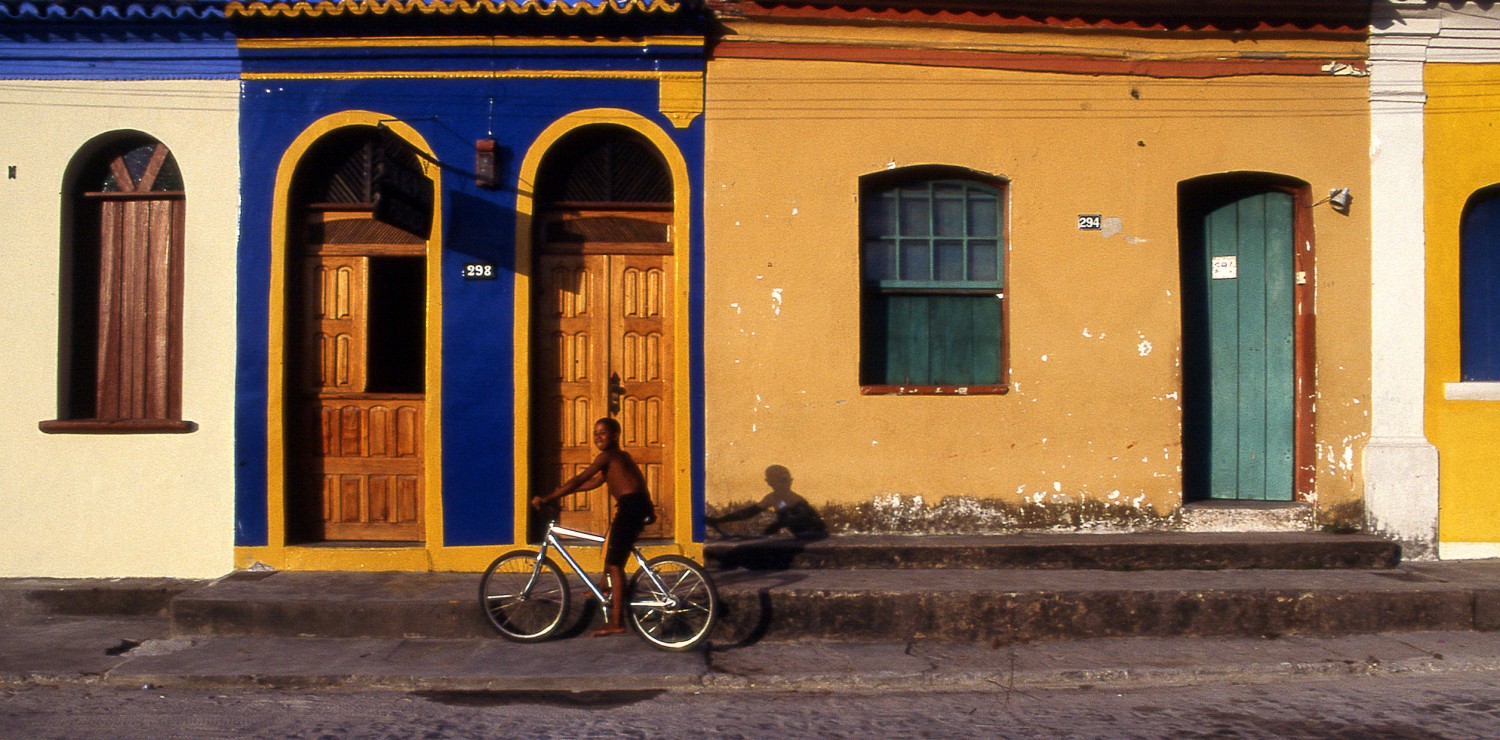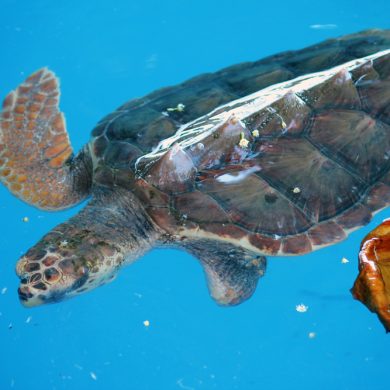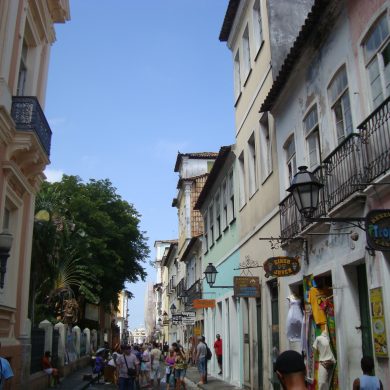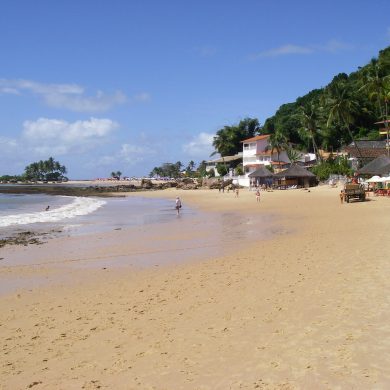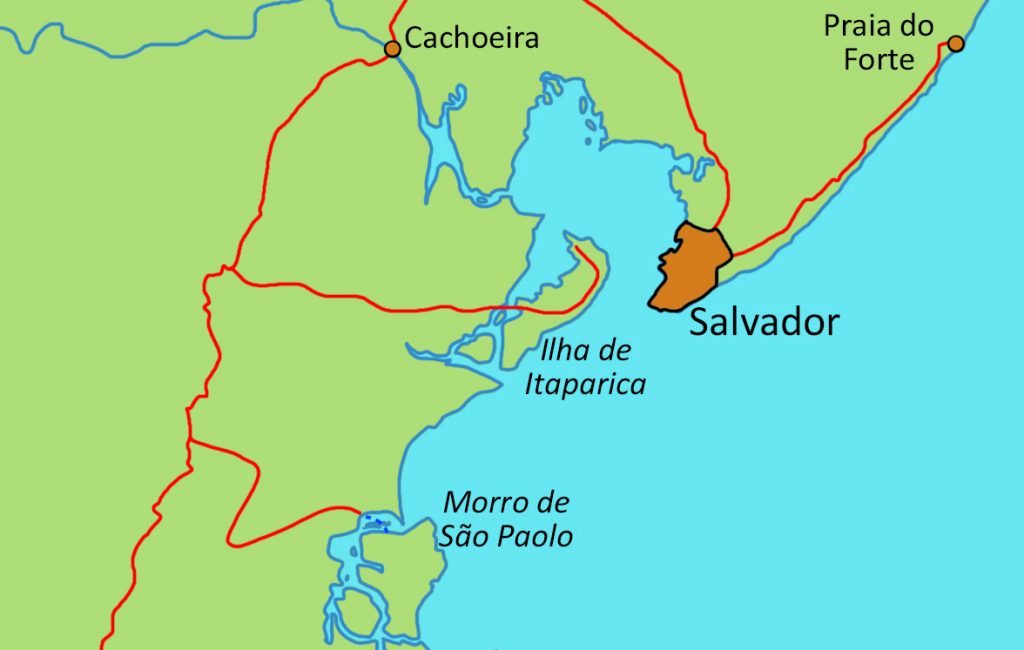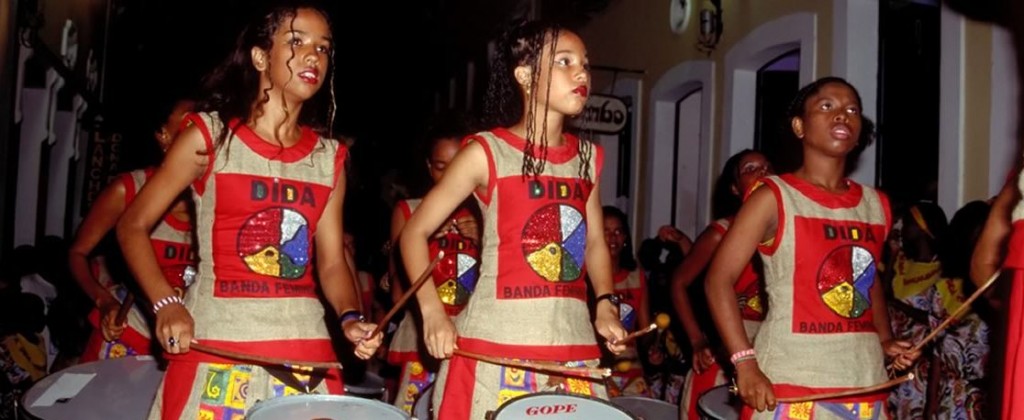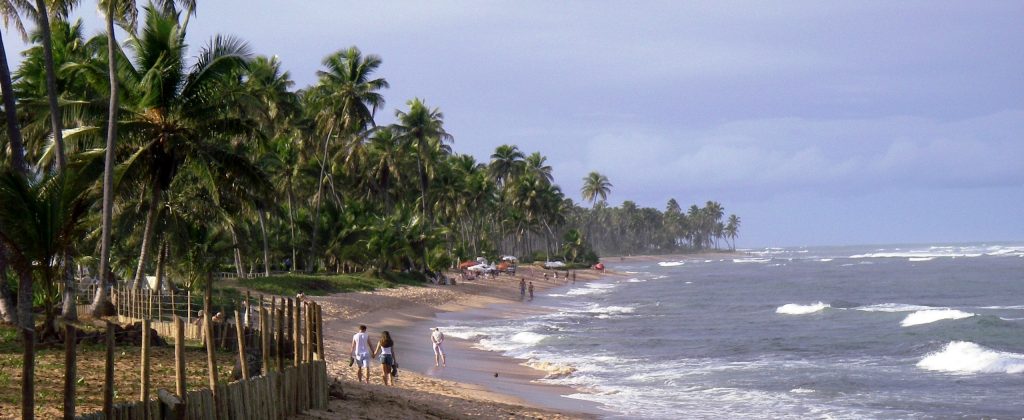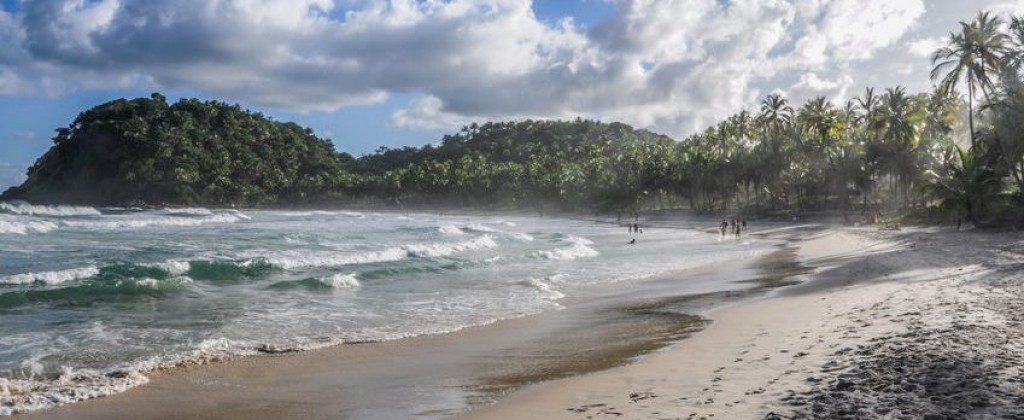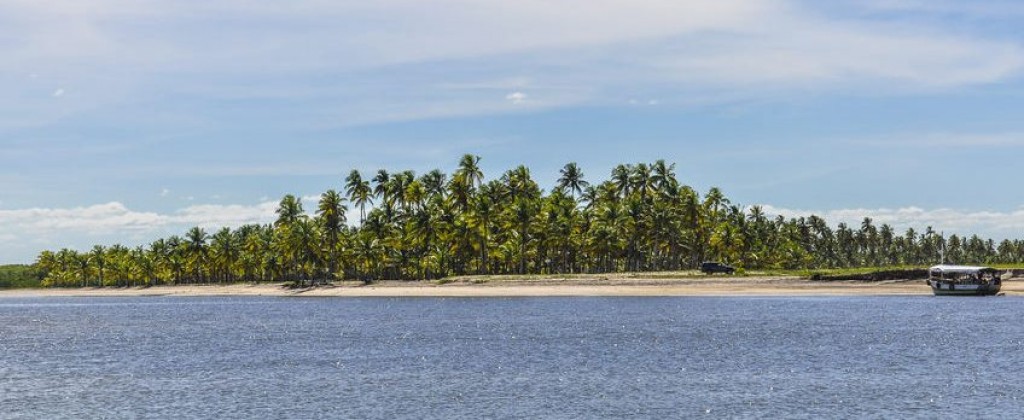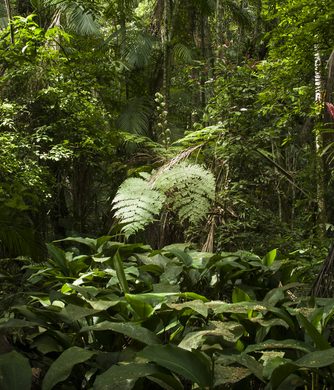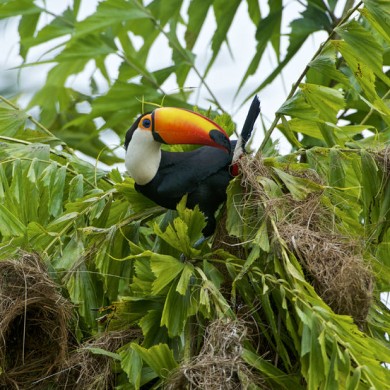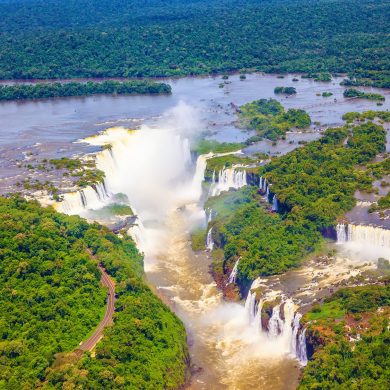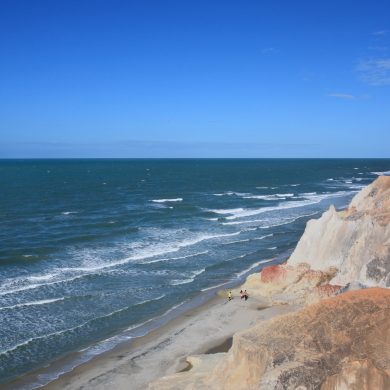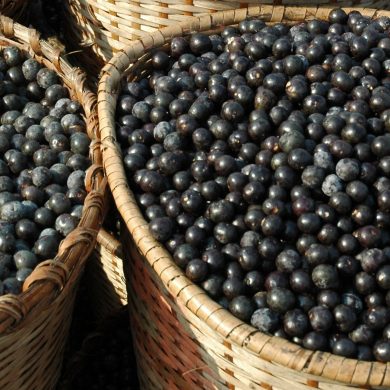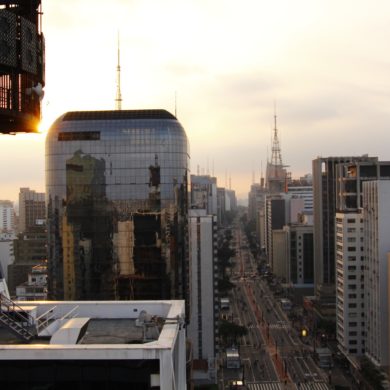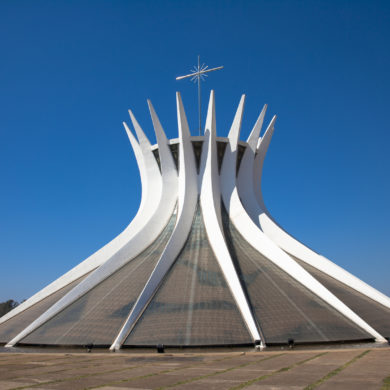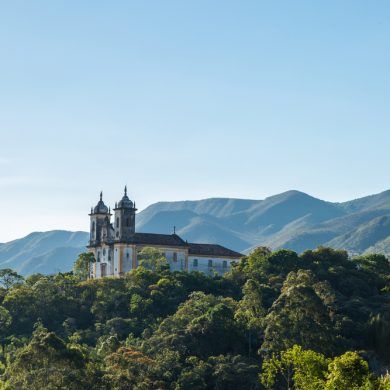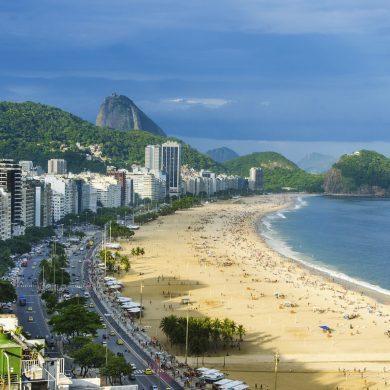Bahia is known as the soul of Brazil…
The cities of Salvador de Bahia, Cachoeira and Lençóis, home to magnificent architectural and cultural heritage, are ideal to come and experience the home of Afro – Brazilian culture. With their many craftsmen, street musicians and “capoeiristas,” here you will find a unique and joyous atmosphere. Join the jubilant Bahian women in their traditional dress and you will be dancing and smiling before you know it!
One of our most popular Brazil Tours, there are many varied options in terms of spending your time here. You will find an array of different cultural and nature oriented activities and events for all ages. Also, Bahia offers the chance to immerse yourself in the soul of Afro – Brazilian culture and its famous festivities, about which only the locals can share the secrets!
Welcome to “Bahia de todos os Santos” where paradisiacal beaches meet a fascinating culture
Browse select destinations and build your tour in Bahia
Discover the cultural region of Salvador de Bahia
Salvador is truly the center for cultural attractions in Brazil, however nature is never far behind. Our Bahia vacation packages are designed to combine a cultural vacation, of rich architectural and artistic heritage, with an exploration of Bahian nature and its fabulous landscapes.
Along the Bahian coast you will find a string of heavenly beaches lined with coconut trees and protected by coral reefs, these are natural refuges for rare animals such as sea turtles. Inland, the “chapadas” or plateaus, dotted with crystal clear waterfalls, form “islands” of extraordinary greenery and biodiversity. They are a choice destination for walkers or hikers and also those who appreciate quiet and beautiful scenery.
Bahia is also a favourite destination for fans of culinary excellence. You will enjoy delicious Bahian cuisine with lots of fish, shrimp, and prawns cooked with dendê the local homemade palm oil. Favourites include the famous “Acarajé,” delicious shrimps fritters, or “Moqueca de Arraia,” a fish stew not to be missed!
A must-see tourist destination in Brazil
Salvador de Bahia is one of the most beautiful towns in Brazil. Perched on its headland, like a lookout dominating the bay or “bahia” in Portuguese, it reveals all its majesty when the rays of the setting sun caress its walls.
As the country’s first colonial capital, it has a rich history and an important heritage, both tangible and non-tangible, dating back to the early days of the American conquest. A land of human contrasts, it has created a mixed culture with roots from both sides of the Atlantic.
A fascinating land for historians and other anthropologists, such as Pierre Verger, or “Fátúmbí,” Salvador is a bewitching city full of beauty, magic and mystery. It is one of the last major cities in Brazil where the influence of strong traditional practice is still felt in everyday life. Take the famous Acaraje sellers, with their traditional costumes and their long pearl necklaces, for example.
Sound interesting ? Our local guides will take you to explore such places as the historical quarter of Pelourinho, that has been completely restored and dominates the bay from the cliffs above. This visit is one of the highlights of a vacation in this region.
The Praca da Se, is where you will find three ancient colonial churches, at the centre of the historical quarter. You may spot young athletic men and women dressed in white, jumping and twisting in the middle of a circle of players. The sound you hear is of the “Berimbau,” a very characteristic musical instrument. These people are Capoeira players, a mixture of martial arts and dance. It was invented by the slaves, who had to work out a way of defending themselves, whilst concealing the fact that they were training combat techniques from their masters. The joy and good humor that is present today in these “rodas de Capoeira” is contagious. You will soon hear and feel the berimbau “calling you” to join in. Do not be afraid to clap your hands to the soft chanting of the surrounding participants. Why not join in with a few dance steps too!
Salvador de Bahia, also features 25km of beaches along the Orla, an avenue that follows the coastline of the Atlantic. There are swimming beaches and surf beaches, some with fine white sand and others more rocky. A little further on there is the Itapua beach, with its restaurants surrounded by palm trees and its gorgeous bay, very enticing for a swim.
Find all the information related to exploring Salvador de Bahia.
As well as Salvador and its many attractions, the Bahia region also has some wonderful resorts. You can choose from these destinations selected for their enticing charm and the quality of their services.
Praia do Forte, a little paradise close to the capital
Praia do Forte, is a seaside resort located 1hr30 from Salvador, along a magnificent 10km beach of white sand. The coast is protected by several coral reefs, so the sea is calm and limpid at low tide.
It is also an ecotourism centre with projects such as Tamar, a marine turtle observation centre where they protect the turtle eggs during the laying period.
This small coastal village has several pousadas and hotels, but only two have direct access to the beach. These are : The Porto da Lua hotel and the Tivoli Eco Resort. Both options are available on our Bahia vacation package in Praia do Forte. Perfect for a family vacation or a romantic get – away, especially during a short stay or if you have little time to get away from Salvador. Want to meet the marine turtles while you sunbathe on a paradisical beach? See our Praia do Forte offer!
Visit Itacaré, an exceptional seaside beauty
The Itacaré beach is in the south of Salvador de Bahia, a seaside resort a little further from the capital. It is attractive because of its unique landscape, a beach with cliffs, a white sandy cove and a forest of palm trees.
For an enchanting and dreamlike destination, we have selected an enchanting and dreamlike resort. The Txai, boasts all the comfort and facilities of a top quality hotel. There are suites of up to 70m2 with a private garden waiting to make your stay an exceptional one with a tropical flavour.
It is a 1hr flight from Salvador to the town of Ilheus then a 1/2 hour drive to the resort. It is undoubtedly one of the best choices among our Bahia vacation packages for those looking for luxury and tranquility.
Morro de São Paulo, wild parties and splendid beaches on a dream island
Morro de São Paulo is a small isolated village on the Bahian coastline, about 2 hours from Salvador de Bahia. It is part of the island of Tinharé, separated from the mainland by a small waterway.
This island is the destination preferred by those who want to combine beautiful landscapes, relaxation and a truly outstanding nightlife! It is the most trendy option among our Bahia vacation packages.
A destination with a fairly young and lively population, it is also a good option for people seeking peaceful and picturesque vacations. Each beach has its own audience and particular style. The further you go along the coast, the more infrequent the parties. It is therefore possible to stay in a pousada away from the festive area to spend your days in peace enjoying the beach and then join the fiesta at night!
Morro de São Paulo is the ideal destination for a seaside and festive stage of a nature holiday in the Chapada Diamantina for example.
The Diamond mountains of Chapada Diamantina
Imagine valleys covered with tropical forests and savannahs, interspersed with vast plateaus of shorter vegetation, from which flow thousands of waterfalls of all sizes. Add a few caves with clear lagoons, small walking paths and almost no human life except for a few tiny hamlets.
The result is the famous Chapada Diamantina. 1520 km2 of nature preserved by a National Park created in 1985.
It’s one of the oldest geological formations in the world, resulting from a deep crack in the earth’s crust from where magma rich in minerals escaped. If you leave the walking trails you may even find pieces of crystal lying on the ground ! A 1 hour flight from Salvador, Lençois is at the entrance to the Chapada Diamantina national park, and awaits you for an extraordinary stay. This town is a national reference for walking enthusiasts, nature lovers and those looking for wide open spaces, or simply a quiet break.
The Chapada Diamantina is still a relatively unknown destination. Ideal if you want to get off the beaten track with a more immersive stay, it is the perfect place to meet the local population and discover a varied ecosystem. Go for the adventure option of our Bahia vacation packages.
Top Bahia Tour FAQs
When is the best time to travel to Bahia?
The ideal time to visit Bahia is between December to March.
The state of Bahia has a tropical climate with a rainy season that runs from April to June.
Outside the rainy season, Bahia has ideal weather for the whole year. Sunny with temperatures around 30°C; the hottest month is March whilst the coldest is usually July. A refreshing breeze blows in from the Atlantic Ocean, which relieves the humidity.
Normally, the rainy season consists of short and light rain showers with sunny breaks, however although it is rare, it has been known to rain for several days in a row. Temperatures can reach as low as 18/20°C during the rainy season, it is best not to plan a beach holiday in Bahia during this time of the year.
Carnaval
The biggest “Carnaval” celebration in Brazil takes place in Salvador, the capital of the state of Bahia and the ex – capital of Brazil. Official Carnaval dates in 2020 are from the 20/02/2020 – 26/02/2020 although with the events before such as “Précarnaval” and after the main party you can make it last as long as you want. Carnival in Salvador attracts millions of visitors from all over the world every year and is known as the biggest street party on the planet!
Outside the rainy season and carnival season, the only other thing to keep in mind in terms of when to visit Bahia are Christmas and New Year. The hotel prices go up and there are often “minimum night stay policies” where you have to stay in a hotel for a minimum number of nights, even if you don´t stay the whole time, you must pay the whole package.
What do you need to travel to Bahia?
Traveling in Bahia is relatively straight – forward and similar to travelling in the rest of Brazil. Throughout the year make sure you are well- equipped for sunny, tropical weather. Sun – screen, shades and light clothes should be at the top of your list. The only exception is if you plan to visit Chapada Diamantina or if you plan to visit Salvador during Carnaval.
Chapada Diamantina
Chapada Diamantina is a national park thousands of square kilometres in size. It is so big that it encompasses many different eco – systems including savannah, bush and tropical forest. Its main attractions are the Plateau Mountains or “Chapadas” from which the park derives its name and the many trails and hikes, which penetrate the landscape. The park is easily accessible by airplane from Salvador, flying into Lençóis Airport.
If you plan on visiting Chapada Diamantina then you may have to bring hiking equipment or at least a pair of good walking shoes. The extent to which you need prepare depends on the trails and hikes you decide to follow but as they get more challenging, you will need more equipment. Many of the trails are mellow and you can explore quite a lot of the park without specialized gear. If you are coming during the rainy season from April to June, then it would be advisable to bring some waterproof hiking gear so that a rainy day doesn´t put you off exploring.
Carnaval in Salvador
To visit Salvador de Bahia during Carnaval, you should book your trip at least 3 months in advance. Remember you can still enjoy the “folia” (frolicking) of Carnaval from January right through to March, so if the main party sounds too hectic, you can always come before or after to enjoy a similar atmosphere albeit more laid back.
Tips for enjoying Carnaval in Salvador
Abadá or fantasia
One way you can take part in Carnaval is to be part of one of the “blocos.” Blocos are the crowds of people who walk the circuits with the bands. To be part of a bloco, you need to purchase either an “abadá” or a “fantasia.” An abadá is a sleeveless t – shirt that you receive when you buy your ticket to one of the blocos. Wearing it, you can pass “under the chord” surrounding the bloco and have more space to dance in the cordoned off area. A fantasia serves the same purpose, except it is a full carnival fancy dress outfit, complete with all the trimmings! The abadá will have the bloco and day it is valid for marked on it, so you can duck in and out of the bloco as you wish. An abadá for the Ivete Sangalo bloco, one of the most sought after and popular parades is $175 for the 2020 carnaval.
Camarote
A “camarote” is one of the viewing stands that line the streets during carnival. In Salvador, most of them are on the Barra-Ondina circuit. Some camarotes are more luxurious than others are and the prices reflect this. You could pay up to $500 dollars or more for a ticket to a camarote. The most simple camarotes will be a place to wind down and watch the carnival go by, somewhere with a bathroom a bar and perhaps a restaurant. Other more expensive camarotes offer spa services, luxury cocktails and massive TV screens to watch the carnival events unfold below!
Click here to buy your abadá or fantasia for the 2020 Carnaval.
What are the top places to see in Bahia?
Salvador de Bahia
Salvador is the capital of the Bahian state. It was founded in the 1500´s and features fantastic colonial architecture, baroque churches and a tropical coastline. It is also the home of Afro – Brazilian culture in Brazil. If you plan on visiting Salvador, make sure you call in to “Pelourinho” the historic centre of the city. Here, you will see the famous pastel coloured houses and salesmen and women dressed in traditional Bahian clothes selling their crafts and traditional Bahian food such as “acarajé.” Be sure to catch a Capoeira “roda” as well, this is a traditional Afro – Brazilian fight disguised as a dance and an important part of Bahian culture especially.
Some of the most famous and beautiful churches to see whilst you are in Salvador include “Nossa Senhora do Bonfim” which is perhaps the most well known church in the city. Here you can experience Catholicism, but also learn about Candomblé, the other dominant religion in Salvador which came to Brazil with the slaves from West – Africa. The Catedral Basílica of Salvador is also worth a visit, whilst appearing modest on the outside, as soon as you step inside you are greeted by a sparkling gold interior! Finally, be sure to visit Igreja de Nossa Senhora do Rosário dos Pretos. This was the church built by the slaves in the 18th century, its blue and white bell towers are featured in many Bahian postcards. Visitors and tourists can drop in on services, which are a mixture of Catholicism and Candomblé.
The Elevador Lacerda was built in 1873. It is a public elevator connects the higher part of Salvador with the lower coastal area and a ride in it offers fantastic views of the ocean. Another place to enjoy the coastal view is at Baía de todos os Santos, this is the name of the bay in which Salvador was built. With many viewpoints, it is the perfect place to enjoy a sunrise in the morning or sunset in the evening. Whilst in Baía de todos os Santos, you should pay a visit to the Farol de Barra, which is Salvador´s famous black and white lighthouse, here you can enjoy a coffee in the café and explore the nautical museum. Take the elevador lacerda back up to the higher part of town to see the majestic Rio Branco Palace.
All of these sites are included on a city tour of Salvador, or on a panoramic city tour.
Chapada Diamantina
Chapada Diamantina is a national park in Bahia. It is known for its flat-topped plateaus divided by huge valleys where clear rivers run. You can explore underground caves, breath – taking waterfalls and amazing viewpoints with the help of a local guide.
Grotte de Lapa Doce is an immense underground cave that consists of 900m of trails. You need a lamp to explore its dark depths, as you wind your way through the stalagmites and stalactites. Mucugezinho is a nearby river where you can enjoy the view from the top of a 22 meter high waterfall, which plunges into a pool called the “The devil´s well” ideal for a refreshing swim. An ideal end to the day would be a visit to Morro do Pai Inácio for sunset, here you can see out across the national park for a real picture postcard view. “Poço Encantado” is one of the top attractions in the national park. A descent of 100m will bring into another world! The deep pool emits a radiant turquoise light as it refracts the sunlight entering the cave via a hole in the rock.
Also, whilst in the area, you can take the time to visit the small town Mucugé where you can mingle with the locals and visit the national park. Here you can also discover an extremely rare plant on the brink of extinction called “Sempre Viva.” You can also learn all about the diamond miners of the 19th century by visiting the “Garimpo museum.” Make sure to visit “Cachoiera do Mosquito” a huge 50-meter waterfall between two cliffs. From the top there is an excellent panoramic view and looking up from the bottom makes you really ponder the forces of nature!
Praia do Forte, Morro de São Paulo and Txai Itacré
Another excellent destination in Bahia is Praia do Forte, an excellent choice for anyone who is interested in marine life and conservation. It is known as “The Brazilian Polynesia” due to its vast landscape of coconut trees and pools of shimmering blue water that form on the shallow reefs of the coast. This area is also known as a hotspot for wale watching! If you do decide to visit Praia dos Forte, an interesting stop is at the TAMAR project and the Baleia Jubarte institute who lead local conservation and research efforts for sea turtles and wales respectively.
Morro de São Paulo is a village just north of Tinharé Island. It is a charming little island separated by the mainland by a shallow channel of water. On the island, it is prohibited to use private cars so horse and cart or bus will be your main mode of transport, which only adds to its charm. As well as five heavenly beaches the island features Forte da Ponta and Fonte Grande, two forts dating back to the Portuguese colonization of Brazil which will appeal to those interested in Brazilian history. The village itself is small and traditional and features some delicious restaurants serving local cuisine as well as international dishes. Be sure to try some freshly caught fish before enjoying the lively nightlife!
If you are the kind of person, who likes to spend a relaxing time in the most luxurious of surroundings then the Txai Resort Itacaré is for you. Located on the estuary of the Rio de Contas River, this resort is a truly exquisite experience, surrounded by palm trees and white sands you can visit the local town or if you are feeling adventurous take a surf or capoeira lesson or head out for a trek into the largest Atlantic Forest Reserve in Brazil. A combination of luxury, adventure and nature, ideal to wind down after visiting the other attractions in Bahia.
